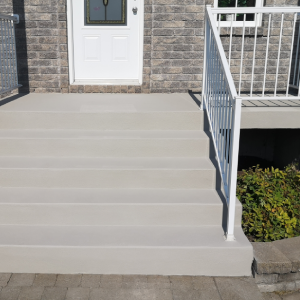The Art of Pouring Concrete Steps

Pouring concrete steps may seem like a straightforward process, but it requires skill and precision to ensure a durable and aesthetically pleasing result. In this article, we’ll dive into the art of pouring concrete steps with tips from a professional in the field.
Planning and Preparation
Before you start pouring concrete steps, careful planning is essential. Consider the size and shape of the steps, as well as any special features or design elements you want to incorporate. Measure out the area where the steps will be poured and mark off any necessary boundaries.
Formwork Setup
Proper formwork setup is crucial for achieving straight, level steps that are structurally sound. Use high-quality lumber or metal forms to create solid boundaries for your concrete pour. Make sure to brace your forms securely to prevent shifting during pouring.
Mixing and Pouring
When mixing your concrete, follow manufacturer’s instructions carefully to achieve the right consistency for your project. Add water gradually while mixing until you reach a workable slump suitable for forming stairs. Start pouring at the bottom step first, filling each tread evenly before moving on to subsequent risers. Work quickly but methodically to avoid inconsistencies in thickness or texture throughout your steps
Finishing Touches
After pouring your concrete steps, it’s time to add finishing touches that enhance both their appearance and longevity. Use a float or trowel to smooth out surfaces and eliminate any air pockets or imperfections in the finish. Consider adding non-slip additives or textures if desired for added safety on outdoor stairs exposed to weather conditions such as rain or snow.
Tips from a Professional
– Always wear proper protective gear including gloves, goggles, and boots when working with wet concrete.
– Take breaks between pours if needed; rushing can lead to mistakes that compromise structural integrity.
– Keep an eye on weather conditions such as temperature changes or precipitation that could affect curing times.
– Don’t forget about reinforcing steel mesh reinforcement (rebar) should be incorporated into larger projects for added strength.
– Clean up spills immediately using water before they harden; dried spots can be difficult remove without damaging fresh pour underneath

Truly an Art Form
Pouring concrete steps is truly an art form requiring attention detail, skilled craftsmanship, and patience. These expert tips will help guide you through the process ensuring an end product that meets standards, durability, aesthetics, and beauty. As always practice makes perfect, so don’t discouraged by initial setbacks. Keep practicing, refining your technique until you’ve achieved your desired results!
Concrete steps made easy through Concrete Contractors Longview TX. Visit us to explore all the unique possibilities at Longview Concrete Services! Want to gather information, inspiration, and guidance for a project? Check out our Blog: All About Concrete. And, if you have any questions, Contact Us At Concrete Longview TX!
[…] humidity levels. During this time period, it’s important to keep foot traffic off of freshly poured concrete and avoid placing heavy objects on it until fully […]